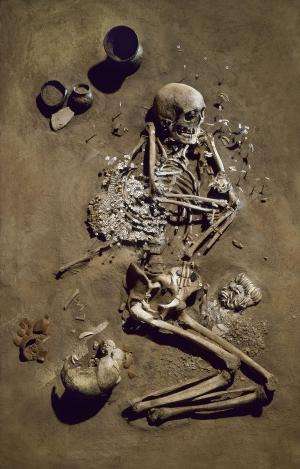European hunter-gatherers and immigrant farmers lived side-by-side for more than 2,000 years

Hunter-gatherers and immigrant farmers lived side-by-side for more than 2,000 years in Central Europe, before the hunter-gatherer communities died out or were absorbed into the farming population.
In a paper published today in Science, researchers describe their analysis of DNA and isotopes from human bones found in the 'Blätterhöhle' cave near Hagen in Germany, where both hunter-gatherers and farmers were buried.
The team, led by anthropologist Professor Joachim Burger of the Johannes Gutenberg University, Germany, used stable isotopes to determine their diet, DNA to investigate how they were related, and radiocarbon to establish how old the bones were.
"It is commonly assumed that the European hunter-gatherers disappeared soon after the arrival of farmers", said Dr Ruth Bollongino, lead author of the study. "But our study shows that the descendants of the first European humans maintained their hunter-gatherer way of life, and lived in parallel with the immigrant farmers, for at least 2,000 years. The hunter-gathering way of life only died out in Central Europe around 5,000 years ago, much later than previously thought."
"Until around 7,500 years ago all central Europeans were hunter-gatherers," said Professor Mark Thomas, professor of evolutionary genetics at UCL, and a co-author of the study. "They were the descendants of the first wave of our species to arrive in Europe, around 45,000 years ago. They survived the last Ice Age and the warming that started around 10,000 years ago. And now it seems they also survived the initial wave of farmers spreading across Europe from the southeast of the continent."
Previous genetic studies by Professors Burger and Thomas showed that agriculture was brought to Central Europe by immigrant farmers around 7,500 years ago. From that time on, little trace of hunter-gathering can be seen in the archaeological record, and it was widely assumed that the hunter-gatherers rapidly died out or were absorbed into the farming populations.
"Although there is some archaeological evidence of interactions between immigrant agriculturalists and local hunter-gatherers, its extent and duration has remained something of a mystery," said Professor Thomas. "But our study now shows that the hunter-gatherers stayed in close proximity to farmers, had contact with them for thousands of years, and buried their dead in the same cave.
"This contact was not without consequences, because hunter-gatherer women sometimes married into the farming communities, while no genetic lines of farmer women have been found in hunter-gatherers", explained Burger. "This pattern of marriage is known from many studies of human populations in the modern world. Farmer women regarded marrying into hunter-gatherer groups as social demotion."
For a long time the team were unable to make sense of the findings. "It was only through the analysis of isotopes in the human remains, performed by our Canadian colleagues, that the pieces of the puzzle began to fit," states Bollongino.
She added: "The results showed that the hunter-gatherers sustained themselves in Central and Northern Europe on a very specialized diet that included fish, among other things, until 5,000 years ago. And what is more, the hunter-gatherers living at the same time as the farmers were genetically more similar to the pre-farming hunter-gatherers than to the contemporaneous farmers."

The team also pursued the question of what impact both groups had on the gene pool of modern Europeans.
Adam Powell, mathematician and specialist in demographic modeling at the JGU Institute of Anthropology, who obtained his PhD with Professor Thomas at UCL, explained: "While neither hunter-gatherers nor farmers are to be regarded as the sole ancestors of today's Europeans, it is the mixing of both populations that potentially represents the ancestry of modern-day Europeans."
It seems that the hunter-gatherers' lifestyle lasted at least until around 5000 years ago in Central Europe. However, some of the prehistoric farmers had hunter-gatherers as ancestors, and their genes are still found in Central Europeans today.
More information: 2000 Years of Parallel Societies in Stone Age Central Europe, Science, 10 October 2013.
Journal information: Science
Provided by University College London

















